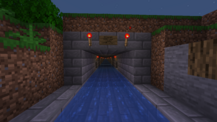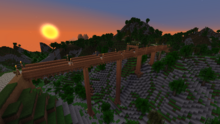Nova:Ethiopia (Imperial)
| ||||||||||||||
Geography
Imperial Ethiopia was founded and focused around the more northern regions of Ethiopia. These areas include very extreme mountain formations, thus making infrastructure hard to build. Ethiopia had neighbors on all sides, with Sudan/Nubia to the west, Somalia to the East, and Yemen to the North
History
Prefounding
When Ethiopia's founder (mooney) first arrived in the Ethiopian region, with his small clan of friends, some time in January of 2019, the region was largely uninhabited. There were a couple of towns on the edges of the region, however the Ethiopian interior was almost entirely unclaimed and unpopulated. When mooney and his small clan of Ethiopian warriors arrived at Lake Tsana, they found a small deserted lakeside tower, with unknown origins. This, they decided, would be the place to found their new town - to be named Tsana.
Prior to Ethiopia
The Town of Tsana grew extremely quickly, as mooney and his small clan invited many old friends to help them on the quest to populate the fertile and unpopulated Ethiopian lands. Soon, by the end of February/Early March, Tsana linked towns were started to form around Ethiopia, with the 3 significant ones being Tsana, Aksum, and Gondar. However, this drew Tsana into the eyes of the larger kingdom of Sudan, and its King - Twomoo. Before the growth of Tsana, Sudan was claiming most of the Ethiopian lands, despite it being unpopulated. Sudan desired a strong link to their mining claims in the Terracotta rich areas of Eastern Ethiopia/Somalia. Initially, Twomoo desired for Sudan to have peaceful relations with Tsana and even perhaps get Tsana to join Sudan Kingdom. However, after some initial talks, mooney and his clan at Tsana felt as though Sudan had been disrespectful, and was trying to push and pressure Tsana into submitting. Quickly relations soured, and soon Tsana was engaged in conflict with Sudan and its allies. However, Tsana being a relatively new nation often came out worse in these fights, even if they could eventually scare of Sudanese raiders.
Ethiopia
On March 18th of 2019, Tsana declared the Imperial Nation of Ethiopia, which the Towns of Aksum, Gondar and Addis Ababa quickly joined. Immidiately after the the founding of the nation, Ethiopia declared officially War on Sudan (although conflicts had been going on for weeks at this point). Sudan not by also declaring war, but by banning trade and travel of Sudanese Citizens in Ethiopia. However, despite Sudan not officially declaring war, African Union members were encouraged to attack and raid Ethiopia, which were somewhat successful.
The Peace
By the 24th of March the Kings of Ethiopia and Sudan held peace talks, and soon after a peace agreement was made. The agreement included laying out new borders between the two kingdoms, as well as Ethiopian membership into the African Union. Furthermore it was agreed that there would be railroad infrastructure constructed in Ethiopia connecting it with the outside world. As at this point, there was virtually 0 infrastructure in Ethiopia in any form, no roads, bridges, railways, or canals.
Golden Age
After peace was agreed with Sudan, the initial speedy growth of Ethiopia slowed and stabilized, and instead there was a great focus on construction. Ethiopians set about creating the very first roads and bridges around Ethiopia, first connecting the Ethiopian towns internally, and then connecting them with the outside world as well.
The towns also quickly expanded in terms of size during this time, seeing the building of forts, monuments and even underwater bases. One such monument was the great Lion at Aksum, which has remained mostly ungriefed even to today. It was also during this period when Ethiopia decided to found a brand new capital town in the East, named Harar (modern day West Mersa). In this period Ethiopia was, although not a world power, it was one of the most important players in all of East Africa.
Ethiopian culture was an interesting blend, and they quickly gained a reputation for being funny, but aggressive people, who could often used British slang words. The end of the Ethiopian Golden age can generally be defined by the the last great construction - the Ethiopia Letters in the Sand. This can still be found today, North of West Mersa.
Collapse
Unfortunately, Imperial Ethiopia fell almost as quickly as it had risen. Despite Ethiopia going from nothing to a significantly sized nation within a couple of months, after the end of the Ethiopian Golden Age, the Empire also fell within a couple of months. Citizens suddenly found they had other tasks to attend to, and due to lack of activity from citizens, the towns around Ethiopia began to fall. By June Gondar was the only town left in all of Ethiopia. It was at this point, mooney passed on the imperial role of Negus Nagast to the Duke of Gondar - Epicbunnyman.
The Purchase of Ethiopia
For the next 5 to 6 months Ethiopia and its capital in Gondar remained almost completely inactive, it became the hermit kingdom of East Africa. The King of Nubia (Sudan renamed) gave many offers of buying the Kingdom from epicbunnyman during this time. It was only in the mid-December of 2019 in which King Twomoo made an agreement with the Ethiopian King to Purchase the Kingom, in exchange for access to resources and new expansion opportunities. At this point Gondar and the surrounding Ethiopian lands were finally annexed into the Nubian realm, ending the nearly 10 month period of Ethiopia.
Legacy
The impacts of Imperial Ethiopia can be widely seen today, despite the fact that many of those who inhabit the area have never even heard of the Old Kingdom of Ethiopia. Many of the roads, bridges and Canals built during the Ethiopian golden age are still used today, in fact they still serve as the backbone for the road system in the modern Ethiopia region. Furthermore, the old Ethiopian cities serve as a foundation for many new cities founded on top of them. Bombard is founded on the ruins of Tsana, West Mersa (an expansion of Mersa) is founded on the ruins of Harar, and New Addis Ababa is founded on the ruins of the old town of Addis Ababa. Without the great works of Imperial Ethiopia in its golden age, it is doubtful some of these towns would exist, and much of the modern infrastructure would not be there. There can be no doubt Imperial Ethiopia had a large positive impact here.
Infrastructure
Ethiopia built a large collection of different roads, canals, bridges, still used to this day. This includes large projects such as The Grand Gondarian Aqueduct, the East Nile Canal, The Ethiopian waterway system, and the Three Great Bridges of the Ethiopian Highlands.
.




